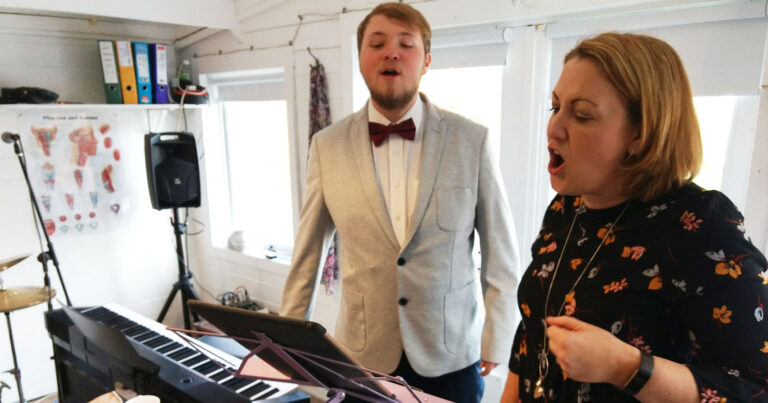Vocal coach Jo Sear shares her tips on helping male adolescent singers to access the upper register.
In her 15-year teaching career, Jo Sear has worked extensively with male contemporary singers.
She’s worked privately and in secondary schools, helping many teenage males become confident singers, with some going on to pursue professional careers.
Over the years, one particular issue has come up again and again: how to train the male passaggio. Sear says: “I kept getting these young men coming to me at 15 or 16 and saying: ‘I want to sing high, but I can’t’. They had never been trained to use their upper register.”
The search for information
Eager to help her students, Sear went hunting for information. But she found most studies on male singers in their teens related to the classical genre and centred around voice change (which typically starts when a boy hits puberty, usually at around 12 or 13).
Teaching colleagues were also unable to provide detailed insight. “There were not many teachers around who specialised in the male voice, and the ones that did, taught classical.
“The most I would get was a suggestion to get the student to do a scale, starting up high and moving downward. I couldn’t find what I needed as a contemporary teacher.”
Teenage males and singing
At this point, it’s worth noting two things. Firstly, many in the classical world argue that male pop/rock/MT singers don’t use their upper register with modification – a viewpoint with which Sear strongly disagrees.
“There are plenty of examples of male CCM singers using upper register with training, smoothness and great skill,” she says. “I don’t believe that it is done without major modification.”
Secondly – as many teachers will have observed – often boys drift away from singing when they hit 12 or 13 and their voices become more unreliable.
Mindful of the drop out rate, Sear wanted to ensure that the boys who did continue with singing got all the support they needed.
Research work
Frustrated by the lack of information, Sear decided to do something about it herself, so she researched male Contemporary Commercial Music (CCM) singers and their use of upper register as part of her post-graduate studies. (Sear will complete her MA Professional Practice (Voice Pedagogy) in April.)
“I wanted to look at getting them [adolescent boys] through the passaggio,” she says. “I wanted to find a quick, easy way to access the passaggio.”
After conducting a literature review of work by Jenevora Williams, John Cooksey, Professor Martin Ashley and Ken Bozeman, Sear recruited three male singers with no voice training (aged between 16 and 19) to be research subjects.
In their own words
Getting teenage boys to open up can be difficult, so Sear compiled a questionnaire to kickstart the conversation. She asked the singers to rate between one and ten various elements of singing.
“They identified the passaggio as the hardest part of their singing,” Sear says. “I asked them to explain it in their own words, and they used words such as ‘difficult’, ‘panicking’, ‘daunting’, ‘frustrating’, ‘tense’, ‘struggle’ and ‘unreliable’.”
Sear then worked for several weeks with the students and devised a teaching strategy to help male CCM singers use their upper register. Here are some tips based on her observations
Tips for helping male CCM singers access the upper register
Listen, watch and ask
Don’t just listen to your student when they sing. Ask them how it feels when they sing. Listen carefully to what they say to you and watch for signs of tension.
Move keys
Don’t be afraid to move keys. “I’ve known teachers who have been inflexible about this; there is just no excuse! With one student who was doing Grade 5 Voice, we were dropping keys right up until the day before his exam – and he smashed it.”
Provide reassurance
Voice change is normal. Tell your student that things will settle, but it takes time. The male voice doesn’t stop changing until the age of about 23.
Find role models
Ask your student what style of music he enjoys and find male singers in their preferred genre who use their upper register. Favourites include Stevie Wonder, Matt Bellamy (Muse), Thom Yorke (Radiohead), Justin Timberlake and Tom Chaplin (Keane).
Repertoire
Consider the repertoire that you are giving your student. Make sure it lights a spark within them.
Demonstrate
Demonstrate the sound that you are trying to achieve. It might not sound perfect, but it will lighten the mood.
Play
Make your student aware that playing with their voice is essential. Try silly noises, impersonations, hooting; encourage them to have fun.
Sear explains the findings of her research in more depth in a BAST webinar – Male CCM Singers: Facilitating The Full Voice.
In the webinar, she also outlines:
– What upper register is, and where/how is it used by successful CCM singers, with examples.
– The importance of training the upper register.
– Teaching strategies for ‘first access’ and training.
If you’re a full BAST Training member log-in and watch the webinar or sign up to become a member today. Club, monthly and annual members get access to a host of great webinars from top vocal coaches and voice scientists.
Website: josearvocal.wordpress.com
Other useful resources
The Cambiata Institute in the US promotes quality music for the changing voice and has a wealth of resources for voice educators on its website.
Teaching Singing to Young Children and Adults, by Jenevora Williams.
Professor Martin Ashley is a former teacher and educator who has studied male voice change. A section on his website, Boys and Choral Singing, has links to papers and books on the subject.




